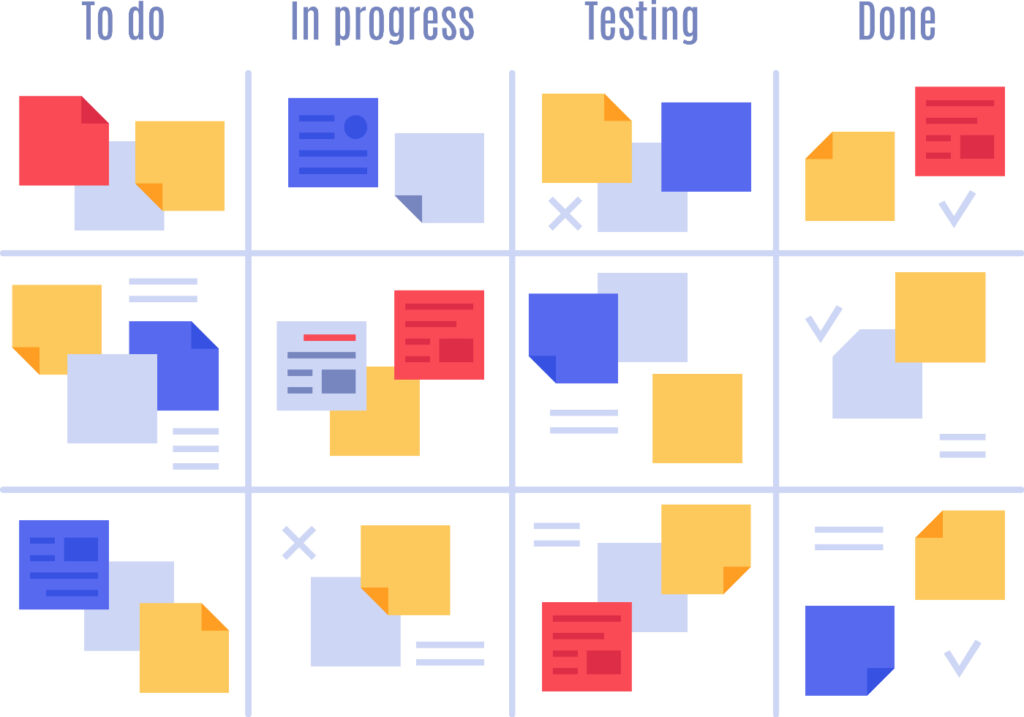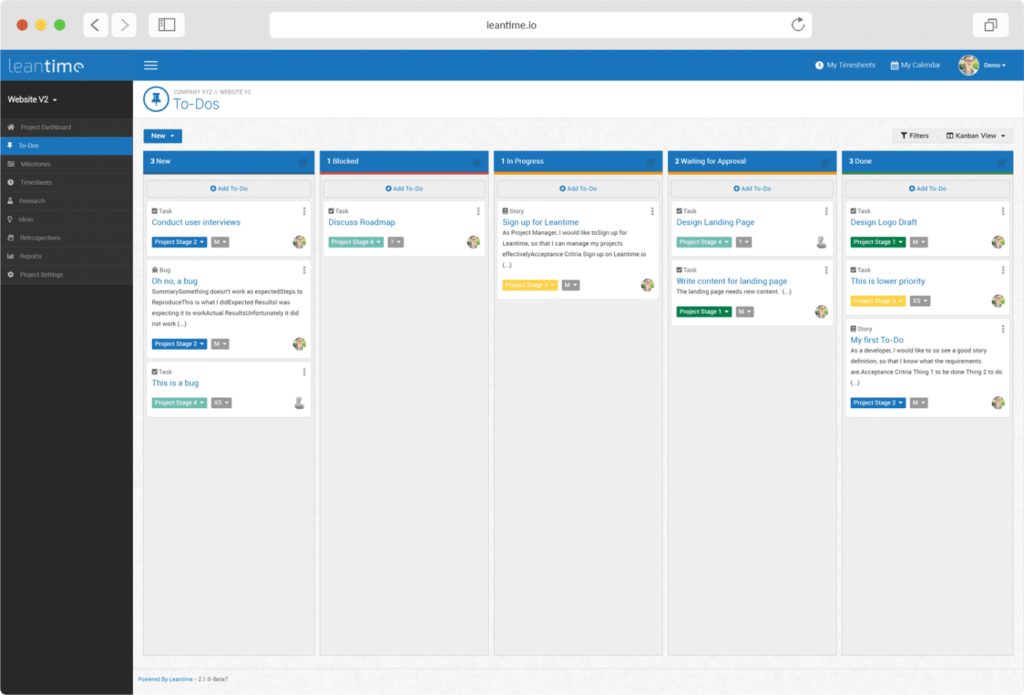Estimated reading time: 14 minutes
Whether you’re a seasoned project manager or just starting, it’s important to understand the ins and outs of the Kanban board. We’ll explore the origins of the Kanban board, how it works, and how it can enhance your project management skills.
We’ll unlock the full potential of the Kanban board by understanding its principles and practical applications. By doing so, you’ll be able to make your projects more efficient and organized.
Table of contents
- Frequently Asked Questions
- A Brief Overview of the Kanban Methodology
- The Importance of Visualizing Work
- What is a Kanban Board?
- How Does a Kanban Board Work?
- The Benefits of Kanban Boards
- Kanban Board Examples
- Kanban Board vs. Scrum Board
- Kanban Board: Visualizing the Workflow
- How to Customize Your Kanban Boards
- Kanban Board Functionality in Leantime
- Unlocking Its Potential
A Brief Overview of the Kanban Methodology
The Kanban methodology is a visual project management approach focusing on continuous improvement and efficient workflow. It originated in the automotive industry and has since been adopted across various industries to streamline processes and optimize productivity.
The Importance of Visualizing Work
Visualizing work in project management is crucial for enhancing collaboration, communication, and transparency. A Kanban board helps teams work better and faster, leading to project success by showing task progress and spotting potential bottlenecks. It organizes tasks in a clear and easy-to-use way.
What is a Kanban Board?
A Kanban Board is a tool specifically designed to help teams visualize their workflow and optimize their processes. It is a crucial aspect of the Kanban methodology, which emphasizes continuous improvement, efficient workflow, and better collaboration and communication within project teams.
When I first heard about Kanban boards, I thought it was a complex management tool that only software engineers use. Well, they’re pretty simple and super helpful for organizing all kinds of projects – not just for tech teams!
Kanban boards are basically a to-do list on steroids. It allows you to visually map out the different stages of your project in columns on a board. For example, you might have “To-Do,” “In Progress,” and “Completed” columns. Then, you write all the tasks for your project on cards or sticky notes and place them in the appropriate column on the Kanban board.
Did You Know: In 2006, software developers applied the Kanban method to visualize and share project status using whiteboards and cards.
So why is this better than a standard old to-do list? Well, seeing the different workflows visually lets you quickly identify bottlenecks. If you have a jam-packed “In Progress” column and an empty “Completed” column, you know your workflow needs some adjustments. Kanban helps make these workflow issues obvious.
Read More: How to Be More Productive
When using digital Kanban boards, I most enjoy the process of moving Kanban cards from one column to another. It gives you a nice dopamine hit every time you transition a task to the “Completed” column! It just feels so productive seeing your Kanban board fill up with finished tasks. The Kanban method is all about that sense of progress.

Elements of a Kanban Board
They can be broken down into the following elements:
Virtual Signals
It’s like giving each task its own unique identity. You can use different colors or shapes to show if a task is in progress, high priority, or include any other critical details. This visual approach turns your Kanban board into a dynamic and easy-to-understand storybook. These visual signals can help a team member or stakeholder quickly see how tasks are performing and spot potential hiccups with a glance.
Columns
The board is divided into columns, each representing a specific activity or status in the project “workflow.” Cards are moved across columns as they progress through the project stages, visually representing the project’s overall progress and individual task statuses. The columns on a Kanban board often include “To Do,” “In Progress,” “Complete,” and others that may consist of “On Hold” or “Waiting for Approval.”
Work-in-Progress Limits (WIP Limits)
These are the maximum number of tasks allowed in each column at any given time. Why a WIP limit? It helps prevent a backlog and keep things flowing smoothly. It’s all about avoiding task overload and making sure each task gets the attention it deserves. A WIP limit can be adjusted as needed based on the team’s capacity and the complexity of the tasks.
Commitment Point
Teams often have a backlog for their Kanban board. This is where customers and teammates put ideas for projects that the team can pick up when they are ready. The commitment point is the moment when the team picks up an idea and work starts on the project; it’s like saying, “Let’s bring this idea to life.” It’s time to turn those creative ideas into reality.
Delivery Point
This is the point at which a task is considered “done.” It can be the same column as “Review,” or it can be a separate column after the review process.
A Kanban board consisting of these five essential elements will definitely set your team up for success.
How Does a Kanban Board Work?
Instead of a pile of tasks, you have tasks written on cards and columns representing the stages.
Tasks Become Cards
Whether you’re using a digital or physical Kanban board, the process for creating cards is similar. Each task gets its card with a description, due date, and relevant information.
Cards Move Through Kanban Columns
As you work on a task, you move its card from “To Do” to “In Progress.” When it’s finished, it goes to “Done.” This visual movement helps everyone see the progress of each task.
Limits Prevent Overload
How many cards can be in each stage is limited. This can help prevent people from taking on too much at once and ensure a smooth workflow.
Flexibility is Critical
You can add or remove columns as needed and customize the workflow to fit your specific project.
Continuous Improvement
The Kanban system isn’t static. You can constantly review and adapt the board to optimize your team’s efficiency.

The Benefits of Kanban Boards
Integrating the Kanban board for project management brings plenty of benefits for the team, making everything smoother while boosting collaboration.
Here are a few benefits that Kanban boards offer to you and your project managers:
Improved Visibility and Transparency
Kanban boards’ primary strength is their ability to present tasks and their progress in a clear and concise visual format within a project. With greater visibility, teams can identify bottlenecks, prioritize tasks, and work more efficiently towards project goals.
Enhanced Focus and Workflow Efficiency
Setting Work-in-Progress (WIP) limits isn’t just about managing tasks; it’s a game-changer for personal productivity. With WIP limits, you can focus on what matters, minimize distractions, and amp up your efficiency—no more juggling tasks or feeling overwhelmed.
Plus, regular check-ins and reflections help you stay ahead of challenges, tackling them head-on. It’s all about working smarter, not harder.
Teamwork and Better Collaboration
When everyone owns Kanban boards, that’s when the magic happens. Teamwork and collaboration soar as the digital Kanban board becomes a shared space.
Regular meetings transform into a hub of clear communication and problem-solving. Visual cues do the heavy lifting, making discussions short, sweet, and concise. It’s teamwork made simple.
Improved Communication
Effective communication is crucial in project management, and Kanban boards help to facilitate this by providing a clear and concise overview of tasks and their progress.
The visual nature of the board keeps everyone on the same page, guaranteeing that all team members are aware of the project’s status and potential issues. This leads to better communication within the team, resulting in more efficient and successful project execution.
Increase Productivity
Improved efficiency, in turn, leads to increased productivity. Kanban boards help to enhance your productivity by shifting the focus from beginning tasks to completing them. In Kanban, two essential productivity metrics are cycle time and throughput.
Cycle time refers to the duration of a task to move through a process, while throughput refers to the number of tasks completed within a specific period. Consistently monitoring your cycle time and throughput lets you track your productivity progress over time. The quicker the tasks move through your process, the more tasks can be completed!
Easily Combined with Other Methodologies
They are a flexible task management strategy that can be used with other methodologies, such as Agile methodology and Extreme Programming (XP).
But that’s not all; numerous other options are also available. When combined with another management strategy, the Kanban method can significantly enhance project management and enable project leaders to customize the process to their team’s explicit needs.
Reduce Employee Overload
Uneven workload distribution can happen if there is a lack of transparency. One employee can end up with too many projects while others are given less work than they can handle. The Kanban system provides a visual tool to show each workload, making it easy for team leaders to distribute tasks evenly and avoid overworking anyone.
Reduce Distractions
Multitasking is popular, but as we all know, it can be difficult to work successfully on many tasks at once. Multitasking is less effective and productive than working on a single task at a time.
Statistic: Approximately 2.5% of people are capable of effectively multitasking. [1]
Did You Know: Research findings indicate that transitioning between tasks can result in a loss of up to 40% of our productive time. [2]
Employees can only progress onto another task after finishing their current project. This approach of focusing on one task at a time helps employees concentrate on their work instead of juggling multiple projects, which can divide their attention and disrupt their focus.
Kanban Board Examples
The Kanban board is highly adaptable and can be customized to suit a wide range of purposes and workflows. They can be used for anything from simple personal to-do lists to complex software development projects.
Personal Tasks
They’re not just for work. A digital Kanban board can be effectively used to manage personal tasks. They allow you to visually arrange and plan your daily, weekly, or monthly tasks, simplifying the process of organizing and tracking progress.
Whether it’s work-related tasks, household chores, home renovation, or personal goals, a Kanban board offers a straightforward way to see what needs attention and aids in staying organized and on top of responsibilities.
Calendar
Another Kanban board example can also be used as a visual calendar, helping you to keep track of important dates, events, and appointments. By organizing your calendar into columns representing days, weeks, or months, you can easily see what’s coming up and plan accordingly. Utilize it as a calendar to stay organized and never overlook an important date.
Roadmap
A roadmap means direction, not details. It precisely delineates a project’s significant milestones and outcomes, offering a transparent visual representation of the project’s timeline and objectives. A roadmap means direction, not details.
With a roadmap, you can strategically plan for the future, maintaining team alignment and focus on achieving your project objectives.
Kanban Board vs. Scrum Board
Although both are popular, the significant differences between the two methodologies can impact their effectiveness for different projects.
Differences in Methodology
Kanban boards emphasize continuous improvement, efficient workflow, and better collaboration and communication within project teams. They clearly depict tasks and progress, allowing teams to monitor and adjust their workflow as needed easily.
On the other hand, Scrum boards follow a more structured approach, with tasks organized into sprints – predetermined timeframes during which specific tasks must be completed. They are cleared and recycled after each sprint, and the focus is on delivering a potentially releasable increment of the product at the end of each sprint.
While both methodologies aim to maximize efficiency, their approaches differ in terms of flexibility and workflow organization.
The Flexibility of Kanban Boards
Kanban Boards have a distinct advantage due to their flexibility. Unlike Scrum Boards, they are not bound to a fixed structure, allowing you to adjust priorities and make updates as needed easily.
Doing so makes Kanban Boards an excellent choice to manage projects, whether you are working alone or in a team, handling one-time tasks, or managing ongoing work.
Kanban Boards can also be easily customized to fit individuals’ or teams’ specific needs and workflows, making them an agile project management tool. In contrast, Scrum Boards follow a more rigid structure, which may not be suitable for all types of projects and teams.

Kanban Board: Visualizing the Workflow
The initial step is to visualize your project’s workflow by recognizing the various stages that tasks pass through as they move from the beginning to completion. You can create columns to represent each stage by breaking down your project into distinct stages.
Creating a clear representation of the workflow helps improve project visibility and transparency, ensuring that all team members clearly understand the project’s status and progress.
Setting up Work-in-Progress Limits
Work-in-progress (WIP) limits are essential components. These limits help to prevent bottlenecks and ensure a smooth flow of tasks through the workflow. Before setting up the WIP limits, take a moment to determine the maximum number of tasks that can be in each column at any given time. By adhering to these limits, your team can more effectively manage their workload and ensure that tasks are completed promptly and efficiently.
Encouraging Continuous Improvement and Leadership
By regularly reviewing the workflow and making adjustments as needed, your team can identify areas for improvement and optimize the process. Promoting a collaborative and proactive environment is important to the success of a Kanban board. Encouraging acts of leadership at all levels empower members of a team to contribute to the project’s success.
How to Customize Your Kanban Boards
Adapting to different environments and workflows it allows teams to tailor their boards to suit their unique project needs, promoting efficient and effective project management. You can customize your board to fit your specific requirements by adapting to different environments and workflows and using labels, tags, and Swimlanes for organization.
Adapting to Different Environments and Workflows
They can be easily customized to adapt to various environments, from manufacturing to software development teams. By understanding your team’s specific workflow and processes, you can create a basic Kanban board structure that accurately represents your project.
This can involve customizing the columns to represent different stages of your workflow or even creating multiple boards for different aspects of your project.
Using Labels, Tags, and Swimlanes for Organization
Another way to customize your board is by using labels, tags, and swimlanes to organize tasks and provide additional context. Labels and tags can be used to categorize tasks by priority, type, or any other relevant criteria, making it easy for team members to identify specific tasks and their associated information quickly.
On the other hand, Swimlanes can be used to organize tasks, dividing them into separate lanes based on factors such as team responsibility or project stage.
Adding labels, tags, and Swimlanes allows you to create a highly organized and visually appealing workspace that accurately represents your project’s unique needs. It enhances the visual clarity of your board and promotes better collaboration and communication among team members, ultimately contributing to the project’s overall success.
Kanban Board Functionality in Leantime

Leantime is a comprehensive project management tool offering a Kanban Board functionality tailored for different types of organizations and users.
Features and Capabilities
Leantime’s Kanban Board provides a clear and concise visual representation of tasks and their progress within a project, improving visibility and transparency for any member of the team. It also allows for better collaboration and communication, ensuring that everyone stays on the same page and works efficiently towards the project’s goals.
The Kanban Board in Leantime is highly adaptable, allowing teams to adapt it to their specific needs and workflows. Key components of Leantime’s Kanban Board include:
The Kanban Cards
Task cards that contain essential information such as descriptions, priority levels, and assignees.
Columns
Workflow stages are represented by columns, allowing for easy tracking of task progress.
In addition to these core components, Leantime offers advanced features such as task assignment, notifications, and integration with other management tools, making it a powerful solution for managing projects of all sizes and complexity.
Integration with Other Project Management Tools and Methodologies
The digital boards are designed to integrate seamlessly with other project management tools and methodologies, ensuring that teams and project managers can use them alongside their existing processes and systems.
This integration allows teams to leverage the benefits of the Kanban project management methodology while maintaining their existing workflows and tools, resulting in a more efficient and effective process.
Unlocking Its Potential
The Kanban Board proves to be a versatile and dynamic tool, offering a comprehensive solution for effective project management. Its visual simplicity, emphasis on workflow, and flexible nature enhance collaboration, streamline processes, and contribute to the overall success of projects.
Whether used for personal tasks or team projects, its user-friendly approach empowers individuals and agile teams to achieve their goals efficiently.
Frequently Asked Questions
Kanban is used to visualize work, limit work in progress (WIP), and improve workflow.
Here are the five core rules of Kanban:
• Visualize the Work
• Limit Work in Progress (WIP)
• Manage Flow
• Make Policies Explicit
• Implement Feedback Loops
Yes! Kanban boards are really flexible tools. You can use them for anything from making daily to-do lists to planning home projects or even tracking your personal goals.
A Kanban board gives everyone a clear picture of what needs to be done, who’s working on it, and how much progress has been made. This helps the team work together better and makes sure everyone’s on the same page.






